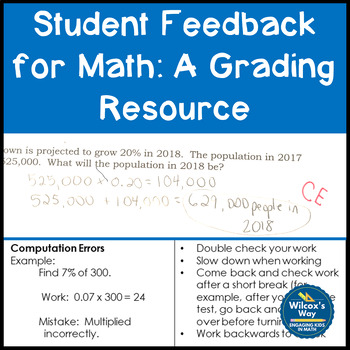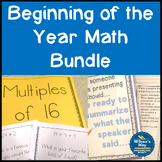Meaningful Student Feedback for Math:An Editable Grading Resource
- PPTX
Also included in
- This bundle is full of resources to set up your middle school math classroom. This bundle has math beginning of the year icebreaker activities and goal setting activities. It also has resources to help you set up a classroom filled with productive discussions and strategies and tools to give effecPrice $11.50Original Price $15.50Save $4.00
Description
Formative assessment is so important for our students' learning. This resource will give you ways to give specific, useful feedback to your students as they learn. There are also strategies and resources to improve the quality of feedback you give to your students without having to spend too much time writing. This resource is editable, so you can customize all of the text to fit your classroom!
✍ Comments Codes: These are abbreviated ways to give students insights into their errors,
✍Error Types: This is a simple rubric with categories that address three main areas: student understanding of concept, precision of student work and organization of student work.
✍Content Understanding and Math Practices Continuums: A set of simple continuums that can be used on assessments or assignments to help give feedback on different aspects that you might consider when grading. There is a continuum for content understanding, and one for each of the eight mathematical practices. These are provided both in editable form and as pictures that can be cut and pasted into your own assessments.
✍Error Reflection: This poster differentiates between careless errors, computation errors and process errors. Examples and solutions are given.
✍Student Response: This focuses on how students should respond to feedback, as well as common mistakes that students make when responding to feedback.
✍Test Analysis Form: This is meant for students to complete after an assessment.
✍Feedback Checklist: This is an editable checklist of things that I commonly find myself writing on student papers, ready to be inserted into any assignment.
All text has been left editable so you can customize this work for your classroom. The backgrounds and clip art have been secured, per copyright agreement with the artists. Most resources contain color and black/white posters, as well as smaller black/white versions that can be used as student handouts.
Here is some of the great feedback about this resource!
"Great resource for students with learning disabilities, easy to use."
"love it and so do my parents"
"This has entirely changed the way I grade. I LOVE this system!!!"
This is provided as a PowerPoint so that it is editable. If you do not have PowerPoint but are still interested, email me jenny.wilcox@gmail.com.
Related Products
⭐ Beginning of Year Rules and Procedures Stations
⭐ Math Beginning of Year Activities and IceBreakers
⭐ Two Step Equation Sudoku Game
⭐ Integer and Rational Numbers Operations Partner Activity
If you're interested in more ideas about ways to give feedback to students, read these blog posts.
Important Information for Customers:
How to get TPT credit to use on future purchases:
• Please go to your My Purchases page (you may need to login). Under each purchase you'll see a Provide Feedback button. Simply click it and you will be taken to a page where you can give a quick rating and leave a short comment for the product. Each time you give feedback, TPT gives you feedback credits that you may redeem on future purchases. I value your feedback and use it to create future products for you to use with your classes!
Be the first to know about my new discounts, freebies and product launches:
• Look for the green star next to my store logo and click it to become a follower. You will now receive email updates and be the first to know about new products and sales.
Don't forget to leave feedback to earn free TpT credits!
I would also love to connect with you on Facebook and Pinterest.
salesundertheseams






